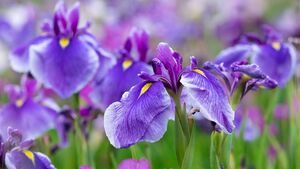Green Fingers: A fresh look at the iris

Japanese irises in early summer.
The iris in humans is the coloured area of the eye and is typically blue or brown but, for gardeners, they will only have eyes for that beautiful group of versatile flowers of the same name.
The iris has been a favourite flower for thousands of years and it might be that the Chinese or Japanese were the first to fall in love with them but the rest of the world soon caught up.
Long before photography was invented and when flowers became popular, they were often painted by artists in order that they would be a reminder of them when out of season.
That is why you find so many paintings of flowers for that period up to the 1800’s depicting, among others, old fashioned roses, pinks, lilies, tulips and, of course, iris’s, which Van Gogh painted, as did Monet, who had a border dedicated to them in his garden at Giverny.
The iris has a large family of some 300 species, which means they are distinct from one another and only a fraction of these are grown in reasonable quantities, of which a handful might be known to gardeners.
There are some sold as bulbs, which include the ‘Dutch Iris’, a colourful mixture of flowers growing to about 45cm (18”) high and flowering in early summer, and also some delightful late winter flowering dwarf types growing to about 10-15cm (4-6”), usually the species or varieties of I.danfordiae and I.reticulata.
The remaining species are those that have to be grown as plants.
It is possible for those that like iris’s to give you some colour or interest at any time of year just by picking a particular species or variety. For fun I will list them here: January to April - I danfordiae, I.reticulata, I.magnifica and I.cycloglossa; May to June - the socalled bearded types, which can be tall, medium or dwarf and are derived from a number of species; July-September - I pseudacorus (our native yellow iris), I.ensata and I.graminea, and finally October-December - I.siberica, I.foetidissima and I.unguicularis.
To save space I have only mentioned the species but there are also selections of these that are available for gardens and they are all distinct and are used in different aspects within the garden.
The most popular and spectacular by far are those large flowering types in flamboyant colours and sizes known as the bearded iris. These are really tough, tolerant of heat, wind and dry soil, and perhaps that is why you will also find them in neglected gardens.
To have even better success do provide them with a spot that is warm and has a well drained soil.
Plant them 30-45cm (12-18”) apart with part of the root (rhizome) almost near the surface. This iris group likes to be dug up, split and replanted every so often when the flowers have finished.
There are so many varieties to choose from but I will mention a few of the taller ones to show the variety available - ‘Blue Sapphire’ whuch is sky blue, ‘Black Dragon’ is a very dark blue, ‘Edith Wolford’ is blue and yellow, ‘Indian Chief’ is apricot and rustic red, ‘Loop The Loop’ is purple and white, and ‘Sultan’s Palace’ is a rustic red.
Two years ago we had an attack of the red spider mite in our glasshouse, where they just love the dry heat of those areas.
As they do not like moisture or a high humidity, there is a simple and organic way to prevent them establishing by spraying around the plants with water from now on.
The same problem can happen in conservatories with house plants so keep a close look at any parts of a plant that might start to look pale in the next few months.
If you have any queries or comments you are welcome to share them with me on 051-384273 or orchardstowngardencentre@hotmail.com and if of general interest I will include it in a future article.






